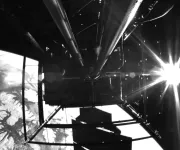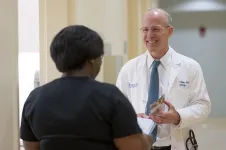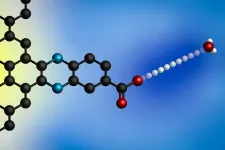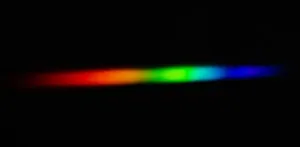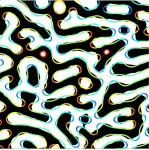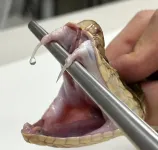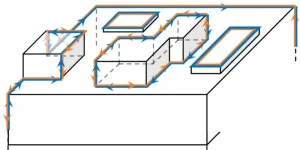(Press-News.org) Cultural institutions are censoring research, learning and creativity because of the way they police the reuse of digital copies of out-of-copyright artworks and artefacts, a new study warns.
Cultural institutions have created a “mess” by claiming and enforcing new rights over the reproduction images of works in their collections.
This allows museums and other organisations to refuse requests for the use of the images in education or research or charge high fees. This impedes free and creative expression and amounts to censorship, according to Dr Andrea Wallace from the University of Exeter Law School.
Researchers, educators and others regularly ask to use images of objects in museum and art gallery collections, but it is often complicated, too expensive or difficult to get permission. The way organisations charge or refuse rights to use “digital surrogates” are outdated and conflict with public missions, the study says.
It warns the UK cultural sector has not kept up with efforts to promote open access to digital collections ongoing elsewhere around the world and there is more concern with generating income through image licensing. This impedes the legitimate use of the public domain for those researching and studying, as well as for artists, the creative industries, and the public for learning and new creations.
The study proposes a new framework to help staff in cultural institutions make more accurate assessments of copyright rights in digital surrogates.
Dr Wallace said: “The current system is a mess, but this new framework can help to disentangle the use of surrogate rights from the ways that cultural institutions manage their collections. It allows lawyers, directors, and heritage practitioners to mend things themselves by distinguishing original from non-original reproduction media. This better captures the vast potential of our public domain cultural heritage in this digital age.
“Of course, cultural institutions cannot and should not uncritically digitize and publish all collections and data for free and unfettered reuse. But there is a clear need to provide access and improve legal certainty for the public who would like to use out-of-copyright collections.”
The framework aims to reduce barriers to people using collections while protecting legitimate intellectual property, curatorial and educational expertise. By encouraging cultural institutions to publish high-quality images online, visitors onsite and online will know they can get the best possible surrogate directly from the source.
Experience shows this can bring new relevance to cultural institutions and drive new income streams, as there may be business opportunities and partnerships made possible by open access.
Dr Wallace said: “The framework can also improve legal certainty around public reuse of surrogate images in the public domain while bolstering their compliance with legitimate reuse restrictions. Imagine how simple it would be if we could identify the artwork and assess its copyright status using the lifetime of the original artist, rather than the claim of the cultural institution asserting a surrogate copyright in the image.
“The data already tells us that most cultural institutions lose money by operating a copyright licensing service. They rarely bring in enough income to cover the costs of running them. Nor is a surrogate copyright necessary to generate revenue or enforce rights in the collection. Cultural institutions can still charge service fees for image creation and delivery. And rather than basing claims on surrogate copyright, institutions can focus infringement notices on legitimate claims, such as trademark, false advertising, or concerns with the specific use, thereby reducing operating costs and inefficiencies.
“The short-term benefits will be to help cultural institutions comply with copyright law, meet their public missions in a digital age and explore more sustainable business models around open access collections. The long-term benefits will be to support the publication of data that is better fit for purpose in the 21st century. Open datasets are invaluable for computational processing, machine learning, and artificial intelligence. If cultural institutions view collections data as within public domain and therefore are more wary of these risks, it may improve the pre-publication assessments of what materials should be digitized. Cultural institutions can then use technological safeguards to revise or restructure data, embed relevant context or information in the metadata, and provide guidelines to support more appropriate reuse and reduce harm.”
END
Wrongly-enforced rules over “digital surrogates” by museums censors research and creative use, study warns
2024-01-17
ELSE PRESS RELEASES FROM THIS DATE:
Space solar power project ends first in-space mission with successes and lessons
2024-01-17
One year ago, Caltech’s Space Solar Power Demonstrator (SSPD-1) launched into space to demonstrate and test three technological innovations that are among those necessary to make space solar power a reality.
The spaceborne testbed demonstrated the ability to beam power wirelessly in space; it measured the efficiency, durability, and function of a variety of different types of solar cells in space; and gave a real-world trial of the design of a lightweight deployable structure to deliver and hold the aforementioned solar cells and power transmitters.
Now, with ...
Pediatric Cancer Research Foundation launches 2024 call for entries for scholarships for pediatric cancer survivors
2024-01-17
The Pediatric Cancer Research Foundation today announced a call for entries for its 2024 Cancer Survivor Scholarships. The Foundation will award $100,000 to eligible students – including graduating high school seniors, college, vocational and graduate students – to support these students in realizing happy, productive futures. “Beating cancer medically is just one part of creating a healthy, happy life. Achieving our purpose of ensuring survivors can spread their wings and soar requires ...
Novel drug for fatal type of heart failure proves safe and effective in phase 3 trial
2024-01-17
Pumping over 100,000 times a day, the heart is a critical muscle needed to deliver oxygen and nutrients to our organs to sustain healthy bodily function. Unfortunately, heart failure affects an estimated 6.2 million people in the U.S. and a staggering 64 million worldwide.
Of older patients with heart failure and abnormally thickened hearts, as many as one in five have an underdiagnosed, highly progressive and fatal condition called transthyretin amyloid cardiomyopathy, or ATTR-CM. The disease, which can be hereditary or develop spontaneously, is defined by an accumulation of misfolded transthyretin ...
Study reveals a reaction at the heart of many renewable energy technologies
2024-01-16
CAMBRIDGE, MA — A key chemical reaction — in which the movement of protons between the surface of an electrode and an electrolyte drives an electric current — is a critical step in many energy technologies, including fuel cells and the electrolyzers used to produce hydrogen gas.
For the first time, MIT chemists have mapped out in detail how these proton-coupled electron transfers happen at an electrode surface. Their results could help researchers design more efficient fuel cells, batteries, or other energy technologies.
“Our advance in this paper was studying and understanding the nature of how these electrons and protons couple ...
Water as a nonlinear medium for ultrabroadband white laser
2024-01-16
Scientists are making significant strides in the development of ultrabroadband white laser sources, covering a wide spectrum from ultraviolet to far infrared. These lasers find applications in diverse fields such as large-scale imaging, femto-chemistry, telecommunications, laser spectroscopy, sensing, and ultrafast sciences.
However, the pursuit faces challenges, particularly in the selection of appropriate nonlinear mediums. Traditional solid materials, while efficient, are prone to optical damage under high peak power conditions. Gas mediums, though ...
Ultrafast laser pulses could lessen data storage energy needs
2024-01-16
A discovery from an experiment with magnets and lasers could be a boon to energy-efficient data storage.
“We wanted to study the physics of light-magnet interaction,” said Rahul Jangid, who led the data analysis for the project while earning his Ph.D. in materials science and engineering at UC Davis under associate professor Roopali Kukreja. “What happens when you hit a magnetic domain with very short pulses of laser light?”
Domains are areas within a magnet that flip from north to south poles. This property is used for ...
Tests can reveal whether an antibody can turn into a killer
2024-01-16
What makes a soldier switch sides? That is a really good question. Especially when the soldier is an antibody that is supposed to defend the body against one of the world's most dangerous snake venoms but instead ends up helping the venom kill the body.
The question has become topical after a group of DTU researchers slightly changed how they tested an antibody that had previously proven promising as an antidote to snake venom. In the first experiment on mice, the damaging effect on muscle tissue from the venom of Bothrops Asper, ...
The surface knows what lies beneath: physicists show how to detect higher-order topological insulators
2024-01-16
Just like a book can’t be judged by its cover, a material can’t always be judged by its surface. But, for an elusive conjectured class of materials, physicists have now shown that the surface previously thought to be “featureless” holds an unmistakable signature that could lead to the first definitive observation.
Higher-order topological insulators, or HOTIs, have attracted attention for their ability to conduct electricity along one-dimensional lines on their surfaces, but this property is quite difficult to experimentally distinguish from other ...
Dr. Marcus D. Goncalves inducted into the American Society for Clinical Investigation
2024-01-16
Dr. Marcus D. Goncalves Inducted into the American Society for Clinical Investigation
Dr. Marcus D. Goncalves, the Ralph L. Nachman, M.D. Research Scholar and an assistant professor of medicine in the Division of Endocrinology, Diabetes and Metabolism at Weill Cornell Medicine, has been elected as a member of the American Society for Clinical Investigation (ASCI) for 2024.
The ASCI is one of the nation’s oldest nonprofit medical honor societies and focuses on the unique role of physician-scientists in research, clinical care and medical education. It is comprised of more than 3,000 physician-scientists representing ...
Method improves detection of potential therapeutic tumor targets in human biopsies
2024-01-16
Many cancers, including some types of breast cancer, are driven by alterations in the activity of cellular enzymes called kinases. Therapies that directly inhibit these cancer-promoting activities have proven to be effective for patients in which individual driving kinases can be diagnosed.
One major challenge to this therapeutic approach is to accurately quantify tumor kinases in human biopsy samples. Many kinases are not abundantly present and are therefore more difficult to measure accurately. Although currently there are methods to quantify small amounts of kinases, measuring multiple kinases ...
